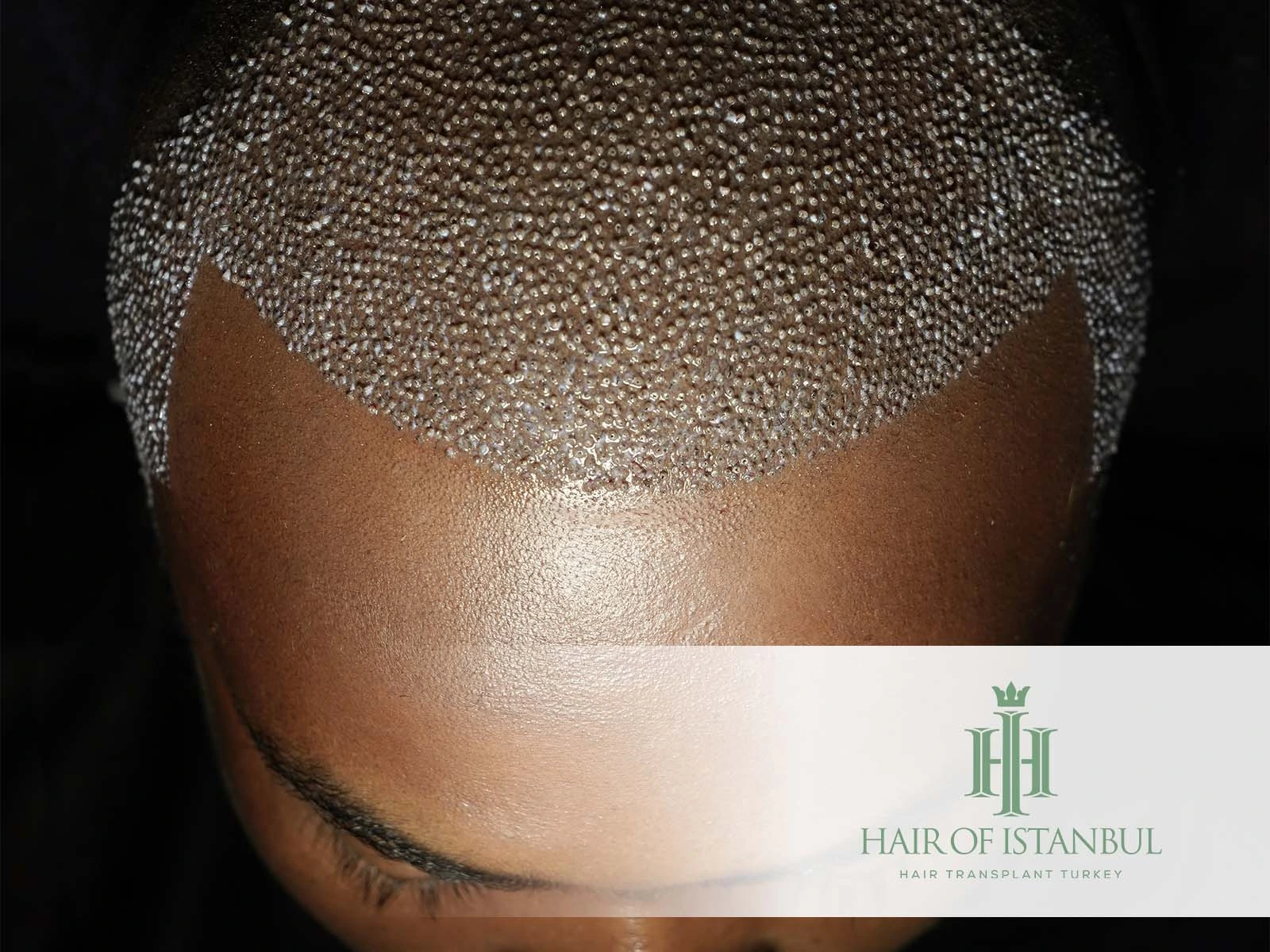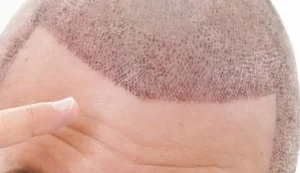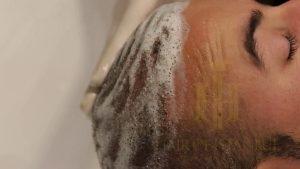
Hair Transplant Scabs: Normal Healing, Safe Washing, and When to Worry
Hair transplant scabs are one of the first visible signs that your scalp has entered the healing phase after surgery. For many patients, they are also one of the most worrying. The recipient area can look dotted, rough, and darker than expected; some people fear they are “losing grafts” every time a crust falls away. In reality, scab formation is a normal and expected part of the wound-healing process after FUE extraction and implantation with techniques such as DHI, Sapphire, or Slit.
This guide explains why hair transplant scabs form, how long they last, how to wash them safely, what you must avoid, and in which situations scabs might indicate something more than routine healing.
Why Do Hair Transplant Scabs Form?
During a modern FUE hair transplant, the surgeon creates thousands of micro-incisions in the scalp. Two different areas are affected:
- Donor area: tiny circular punches where follicles are extracted
- Recipient area: micro-channels where grafts are implanted
Each of these micro-wounds bleeds slightly and then seals. As blood plasma and lymph fluid dry, they form small crusts on the surface of the skin. These crusts are what patients commonly call hair transplant scabs.
From a medical perspective, these scabs are protective. They:
- Cover the incision so it is not exposed to the environment
- Help stabilise grafts during the first days
- Support early stages of tissue repair beneath the surface
Authoritative medical sources also list a “crust that forms on the areas of the scalp where hair was removed or implanted” as a typical, minor side effect of hair transplant surgery, usually resolving within the first couple of weeks of healing. :contentReference[oaicite:1]{index=1}
What Do Normal Hair Transplant Scabs Look Like?
Typical hair transplant scabs:
- Are small, pinpoint or slightly oval crusts around each implanted or extracted follicle
- Start off pinkish or red, then turn light brown as they dry
- Feel slightly rough when you gently glide your fingers above (without pressing)
- May be accompanied by mild redness and itching
The pattern is usually dense in the recipient zone and more scattered in the donor area. The overall look often appears more dramatic than it actually is; scabs are superficial and sit on top of the healing grafts.
Hair Transplant Scabs Timeline: Day-by-Day Overview
Healing speed varies from person to person, but most patients follow a similar timeline.
Days 0–3: Early Crust Formation
- Plasma and small blood droplets dry around each incision.
- Fine, fresh scabs begin to appear from 24–72 hours.
- Swelling and redness are usually at their peak in this period.

Days 4–7: Scabs Become More Visible
- Scabs darken and harden; the dotted pattern is clearly visible.
- Itching often increases as part of normal healing.
- Gentle washing, as instructed by the clinic, begins to soften them.
Days 7–10: Gradual Shedding of Scabs
- With daily moisturising and washing, scabs loosen and begin to fall off.
- The recipient area starts to look cleaner and less rough.
- Some hairs may fall out together with the scab; this is usually part of normal “shock loss.”
Days 10–14: Scabs Should Be Almost Gone
By the end of the second week, most reputable after-care protocols expect the majority of scabs to have shed with careful washing. :contentReference[oaicite:2]{index=2} A few small crusts might persist a little longer, especially in drier or more sensitive skin, but the scalp should no longer be fully covered in scabs.

Safe Removal of Hair Transplant Scabs: Step-by-Step
The golden rule is simple: scabs should fall off, not be pulled off. Your clinic’s instructions may vary slightly, but most evidence-based protocols share these steps:
1. Pre-Soaking With Lotion
From around Day 3–4 (or whenever your clinic advises), you usually apply a gentle medical lotion or emollient to soften scabs:
- Spread a thin layer over the recipient area using your fingertips (no nails).
- Leave it on for 20–30 minutes to loosen dried crusts.
2. Foam Shampoo Application
Next, a pH-balanced or medical shampoo is foamed in the hands and gently patted onto the scalp. Direct rubbing, scrubbing, or circular pressure is avoided in the first 10 days. This technique is described in detail in the first wash after hair transplant guide.
3. Low-Pressure Rinsing
The scalp is rinsed with lukewarm water, usually poured from a cup instead of using direct shower pressure in the earliest days. This helps avoid dislodging scabs and grafts mechanically.
4. Daily Repetition
Repeated softening and gentle washing—not force—is what safely removes hair transplant scabs. Over roughly a week of daily care, crusts detach and wash away, exposing the healing skin underneath. Clinical after-care articles emphasise that persistent, forceful rubbing or picking should be avoided to protect grafts and reduce infection risk. :contentReference[oaicite:3]{index=3}
Common Mistakes to Avoid With Hair Transplant Scabs
Several behaviours can jeopardise grafts or prolong redness:
- Scratching with fingernails: can physically lift grafts and break the skin.
- Peeling scabs off “just to clean faster”: increases the risk of patchy density later.
- Using very hot water: irritates the scalp and may increase inflammation.
- Starting strong anti-dandruff shampoos too early: some medicated formulas are too aggressive in the first days post-op.
- Wearing tight hats before your clinic approves it: friction can catch and pull scabs, especially at the front.
Ideally, any change in shampoo, topical product, or headwear should be cleared with your surgical team first. A structured overview of early side effects such as swelling, itching, and crusting is available in the article on hair transplant side effects.
What If Hair Transplant Scabs Fall Off Too Early?
It is not unusual to lose an individual scab early by accident. However, widespread early loss caused by scratching, rubbing, or direct trauma can be problematic. Potential issues include:
- Visible bleeding points in the recipient area
- Increased risk of infection where the skin barrier is reopened
- Isolated spots with fewer surviving grafts, affecting density
If you see fresh bleeding or notice a graft “stuck” in a scab that has come off, inform your clinic. Photos taken under good lighting help the medical team decide whether this is within normal limits or needs closer monitoring.
What If Hair Transplant Scabs Are Still Present After 2 Weeks?
By Day 14, most patients have shed nearly all visible scabs with proper washing. If a large number of scabs remain at that point, the two most common reasons are:
- Overly cautious washing (not enough softening and rinsing)
- Individual differences in healing speed or skin dryness
Many surgeons recommend slightly more active—but still gentle—circular motion with the finger pads from around Day 10 onwards, once grafts are more securely anchored. Several clinical resources note that crusts persisting beyond 10–14 days should be discussed with the treating surgeon, particularly if redness is also worsening. :contentReference[oaicite:4]{index=4}
Do Scabs Affect Shedding and Regrowth?
Shedding of the transplanted shafts, often called “shock loss,” typically starts around Week 2 and can continue up to Week 6. This process is driven by the hair growth cycle, not directly by scabs. Authoritative patient resources describe this temporary shedding as a normal stage that makes way for new growth, which often begins around 3–6 months after surgery. :contentReference[oaicite:5]{index=5}
In practice:
- Hairs may fall out together with the scab—this is expected.
- The follicle itself remains anchored under the skin.
- New hair growth usually starts in Months 3–4 and becomes noticeable by Months 6–9.
These phases are described step-by-step in the hair transplant recovery timeline.
Hair Transplant Scabs in the Donor Area
Scabs form not only where hair is implanted, but also in the donor region where FUE punches remove follicles. Donor scabs are usually:
- Smaller and more scattered than recipient scabs
- Less noticeable once surrounding hair grows a few millimetres
- Gone within about a week under normal washing
Because the donor area has abundant blood supply and intact surrounding follicles, it often heals more quickly. Long-term donor aesthetics and safe extraction density are discussed in the donor area for hair transplant guide.
When Are Hair Transplant Scabs a Warning Sign?
While most scabbing is harmless and temporary, some patterns may signal a complication and should prompt contact with your clinic:
- Scabs with yellow, green, or foul-smelling discharge
- Rapidly increasing pain, throbbing, or heat in the area
- Expanding redness beyond the transplanted zone
- Scabs lasting several weeks together with thick crusts and intense itch
These may suggest infection, folliculitis, or an underlying scalp condition such as seborrhoeic dermatitis or psoriasis flaring in the background. Chronic scalp diseases and their effect on hair restoration are explored in the article on Seborrheic Dermatitis and transplant candidacy.
Living With Scabs in the First Days: Practical Tips
To stay comfortable and protect your grafts while scabs are present:
- Follow your clinic’s specific lotion and washing instructions exactly.
- Sleep with your head elevated for the first few nights to reduce swelling and pressure on the grafts.
- Avoid strenuous activity and heavy sweating, as described in the guide to exercise after hair transplant.
- Do not apply hair styling products, sprays, or dyes until the clinic confirms it is safe.
- Remember that mild tenderness and tightness are normal; more on this is covered in does hair transplant hurt?
Independent Medical Reference
For a neutral, patient-focused summary of common hair transplant side effects—including temporary crusting and scab formation in donor and recipient areas—you can review the Healthline overview of hair transplants, which describes these changes as minor issues that typically resolve within a few weeks.
Conclusion
Hair transplant scabs are an unavoidable and necessary part of the healing process after FUE-based hair restoration. They typically appear within the first few days, peak around the end of the first week, and fall off naturally within 7–14 days when gently softened and washed as instructed. The real risk does not come from the scabs themselves, but from scratching, peeling, or neglecting proper after-care.
By understanding what is normal, following a structured washing routine, and staying in close contact with your surgical team, you can protect your grafts, reduce redness and discomfort, and move smoothly into the next phases of recovery—shedding, early regrowth, and eventual full maturation between Months 12–18. For personalised assessment and long-term planning, patients are always encouraged to consult directly with an experienced medical team.
Most hair transplant scabs appear within the first few days and fall off naturally between Days 7–14 with proper softening and gentle washing.
Yes. Scratching or peeling scabs can dislodge grafts, open the skin, and increase infection risk. Scabs should be allowed to detach gradually with lotion and careful shampooing.
Yes. Transplanted shafts often shed together with scabs during the shock-loss phase, while the follicles remain safely anchored under the skin.
If many scabs remain after Day 14, contact your clinic. You may need more active—but still gentle—washing, or your doctor may check for underlying scalp issues.
 en
en  TR
TR  SK
SK  ITA
ITA  FR
FR  DE
DE  ES
ES  BG
BG